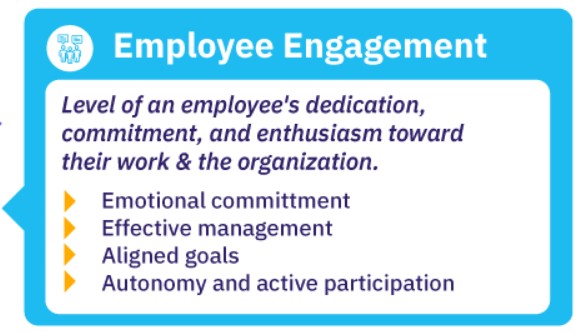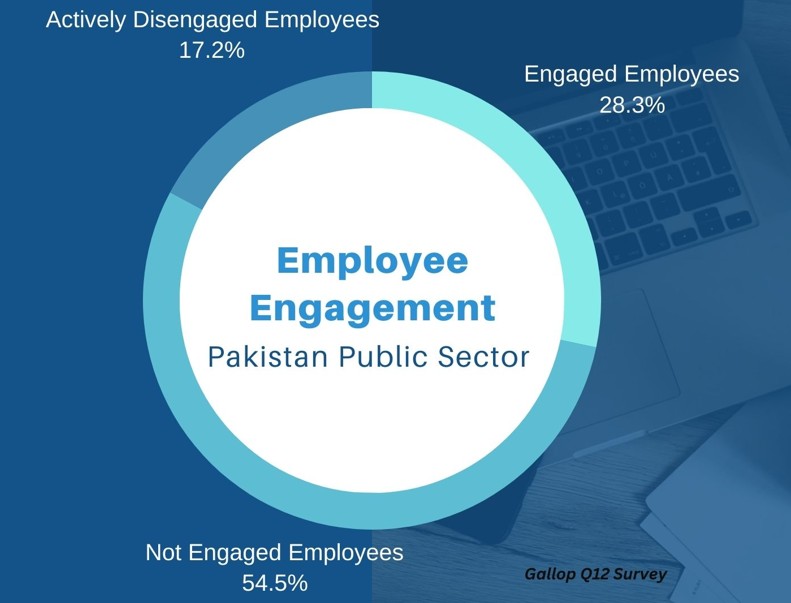“What gets measured gets managed.” – Peter Drucker
That quote holds true for employee engagement. If you aren’t measuring it the right way, you’re likely missing key insights and managing based on assumptions.
Disengagement doesn’t always look dramatic. It often hides in missed deadlines, low energy, and a quiet drop in motivation that builds over time. According to Gallup, companies with highly engaged employees experience 21% greater profitability and 17% higher productivity.
In this blog, you’ll discover how to measure employee engagement effectively, five subtle signs you might be missing, and how Engage Consulting’s award-winning Employee Engagement Survey can help you uncover what really matters to your people.
Why Measuring Employee Engagement Matters
Measuring employee engagement is essential for creating a thriving workplace. When engagement is high, employees feel motivated and aligned with the company’s goals, which directly impacts performance and morale.
Here’s why it matters:

Think about a time when you felt truly invested in your work; when you were excited about a project and gave it your all. That’s the power of engagement in action. When employees feel connected to their roles, they perform better, contribute more, and talk positively about the workplace.
By measuring engagement, leaders can identify key areas for improvement and foster an environment that promotes motivation, retention, and long-term success.
Top 5 Effective Methods to Measure Employee Engagement
While engagement may feel intangible, the right methods can translate employee sentiment into measurable data. These approaches go beyond surface-level feedback to uncover what truly drives or hinders engagement within your organization.
1. Employee Engagement Surveys
Unlike casual conversations or gut instincts, engagement surveys provide structured, quantitative data that helps uncover what employees truly feel about their roles, leaders, and the organization as a whole. Measuring sentiment is essential because employee perceptions often shape morale, productivity, and retention outcomes.
For instance, surveys can explore areas such as whether employees feel their work is meaningful, if they trust leadership, or if they see growth opportunities. This level of data allows HR teams to make informed, strategic decisions backed by evidence.
At Engage Consulting, our Employee Engagement Survey has helped organizations like HBL and PepsiCo gain critical insights into their workforce. The tool is customizable, anonymous, and benchmarked making it ideal for identifying areas that need improvement and tracking progress over time.
2. Pulse Surveys
Pulse surveys are a more agile and frequent alternative to traditional engagement surveys. While engagement surveys are comprehensive and often conducted annually or bi-annually, pulse surveys are short, targeted, and deployed more frequently such as often monthly or quarterly.
This makes them perfect for tracking changes after leadership shifts, policy updates, or major organizational changes. Companies like Unilever and Spotify have adopted pulse surveys to quickly gauge morale and respond to issues before they escalate.
They’re typically 5–10 questions long and can be delivered digitally via email or mobile platforms, ensuring high participation and real-time feedback that fuels rapid HR interventions.
3. One-on-One Meetings
Structured check-ins between managers and employees go beyond performance reviews. They offer a window into an individual’s day-to-day engagement. These meetings help uncover emotional drivers, frustrations, and goals that employees may not feel comfortable sharing in group settings or surveys.
When done regularly, they build trust and open communication. For example, a manager may learn that a team member feels overlooked during team meetings, or that their workload is becoming overwhelming like issues that, if addressed early, can boost engagement and retention.
4. Exit Interviews
Every resignation carries a story and exit interviews are one of the best tools to uncover why people actually leave. Disengagement is often a gradual process, and outgoing employees are more likely to speak openly about what went wrong, offering unfiltered insights into company culture, management, or workload issues.
By analyzing exit interview data over time, organizations can identify patterns like frequent complaints about career development or team communication and make proactive changes to prevent further attrition.
5. Performance Metrics
Engagement isn’t always verbal. It often shows in how people work. Performance indicators such as rising absenteeism, sudden dips in productivity, or increased error rates may all signal disengagement.
Tracking these metrics alongside engagement data gives a fuller picture. For instance, a team showing declining performance may not lack skill but motivation or purpose. By identifying such red flags early, leaders can intervene with coaching, recognition, or adjustments to team dynamics.
5 Signs of Employee Disengagement You Might Be Missing
Disengagement often creeps in quietly, showing up through subtle changes in behavior before it becomes a bigger issue. Recognizing these early signs can help managers intervene effectively, boost morale, and prevent long-term productivity loss.

1. Declining Participation in Meetings
When a previously vocal team member becomes quiet during meetings, it may be a warning sign. They might no longer share updates, offer suggestions, or show curiosity about ongoing projects. Their camera might stay off in virtual calls, and they may seem distracted or disinterested.
This behavioral shift is often more than just fatigue—it can signal growing dissatisfaction, lack of motivation, or feeling disconnected from the team or purpose. Over time, this passive participation can demoralize other employees and reduce the overall energy and effectiveness of team discussions.
2. Reduced Collaboration
Teamwork thrives on open communication, trust, and a shared drive toward goals. When employees begin avoiding group projects or prefer working in isolation, it could indicate disengagement. They may withdraw from Slack channels, ignore group emails, or avoid cross-functional collaborations.
Reduced collaboration usually points to a deeper issue, perhaps a misalignment with the organization’s direction, burnout, or lack of psychological safety. When left unaddressed, it creates silos, hampers innovation, and reduces knowledge-sharing, ultimately weakening team culture and output.
3. Minimal Feedback or Suggestions
Engaged employees naturally share ideas to improve workflows, systems, and culture. When those contributions dry up, it’s not just silence, it’s often a sign of emotional withdrawal. Employees may stop raising issues, skip performance check-ins, or no longer offer feedback during retrospectives.
This lack of initiative signals that they may not believe their voice matters. It can stem from past experiences of being ignored, criticized, or undervalued. A decline in feedback culture can lead to stagnation and missed opportunities for positive change and innovation.
4. Increased Absenteeism
While occasional absences are normal, a consistent rise in unplanned leaves, late arrivals, or early exits should raise concerns. Disengaged employees might call in sick more frequently or avoid work without strong reasons. It’s often a sign of growing emotional or mental fatigue.
This pattern can disrupt team momentum and morale, especially if it becomes habitual. When people stop feeling accountable or connected to their role, they slowly withdraw physically through absenteeism, and mentally, by disengaging from their responsibilities.
5. Lack of Initiative
A proactive employee often seeks new responsibilities, proposes improvements, and shows eagerness to grow. When this energy fades, and they shy away from taking on challenges, something is likely off. They may avoid leadership roles or stop asking about career development opportunities.
This reluctance often stems from feeling unrecognized, overworked, or disconnected from purpose. It can cause a ripple effect, reducing innovation, lowering productivity, and creating a sense of stagnation within the team. Over time, it can also affect the employee’s career growth and overall team progress.
Leveraging Engage Consulting's Employee Engagement Survey
At Engage Consulting, we specialize in helping organizations measure and enhance employee engagement. Our comprehensive Employee Engagement Survey is designed to uncover deep insights into your workforce’s sentiments and identify actionable areas for improvement.
Key Features of Our Survey:
Our Employee Engagement Survey is designed to deliver clear, actionable insights, tailored precisely to your organization’s needs. Here’s what makes it stand out:
-
Customized questionnaires that reflect your company’s culture, goals, and employee experience.
-
Benchmarking capabilities that allow you to measure your performance against industry peers.
-
Comprehensive reports offering clear analysis, key findings, and practical recommendations.
-
Full anonymity assurance to encourage honest, transparent employee feedback.
Benefits of Using Our Survey:
Using our survey goes beyond measurement. It helps you create real, lasting improvements in your workplace. Here’s what you can expect:
-
Higher employee retention by identifying and addressing engagement risks early.
-
Increased productivity as engaged employees contribute more enthusiastically to company goals.
-
Smarter leadership decisions guided by clear, data-driven insights.
-
A healthier, more positive work environment that attracts and keeps top talent.
By partnering with Engage Consulting, you gain access to tools and expertise that drive meaningful organizational change.
Conclusion
Effectively measuring employee engagement is crucial for organizational success. By recognizing subtle signs of disengagement and employing comprehensive measurement strategies, organizations can foster a more engaged, productive, and satisfied workforce.
Engage Consulting is here to support you in this journey. Our Employee Engagement Survey provides the insights needed to make informed decisions and cultivate a thriving workplace culture.



